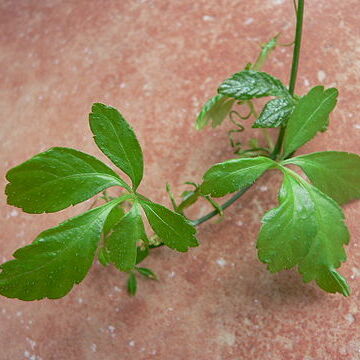Herbaceous or subwoody climber, 2-8 m tall, root perennial but not(?) tuberous, main stem to 1 cm thick, bark fissured, grey; leafy stem slender, 1(-2) mm diam., glabrous or hairy, hairs grey or rarely brown; dioecious. Leaves: petiole 3-6 cm long; petiolules 0.2-0.7 cm long; blade simple or foliolate, subcircular (or ovate) in outline, 4-10(-17) cm diam.; leaflets 3-5(-7), ovate to narrowly elliptic, 3-10 by 1-5 cm, outer leaflets smallest, 3-6(-7)-pinniveined, veins faint or distinct, margin (remotely) finely (or coarsely) dentate, upper surface variously (appressed) hairy or subglabrous (except veins), lower surface (sub)glabrous. Male inflorescences many-flowered, small or large, raceme-like or 2-4-branched, broadly paniculate, 5-15(-30) cm long, lateral branches to 10 cm long, hairy or subglabrous, ultimately with (1 or) 2-5 flowers in fascicles (or in condensed racemes), finely hairy or subglabrous; peduncle 1-7 cm long; bracts 1-2(-5) mm long. Male flowers: pedicel 1-3(-7) mm long, articulate in the middle, the basal part persistent after flowering; perianth (2.5-)3-5(-8) mm diam.; receptacle shallowly hollowed, c. 0.5 mm wide; sepals narrowly elliptic-linear, (0.5-)1 mm long; petals triangular, (narrowly) elliptic, 1-2(-3.5) by 0.5(-1) mm, apex acuminate or long-acuminate, adaxially usually ± hairy or papillose; staminal column 0.5(-1) mm long, synandrium 0.5(-1) mm diam., anthers subglobose, sessile or short-stalked, c. 0.2 mm diameter. Female inflorescences as male inflorescences, but smaller. Female flowers: pedicel 2-4 mm long, subapically articulate; perianth 2-4 mm diam.; ovary subglobose, c. 1 mm diam., glabrous or sparsely hairy; styles (2 or) 3, with stigma each 0.5-1 mm long. Fruit green, ripening pale yellow or blackish, globose, 0.5-0.8 cm diam., glabrous or (sparsely) hairy; fruiting pedicel 0.2-0.5 cm long. Seeds usually 2, subcircular, triangular or cordate in outline, 3-4 mm diam., little or moderately compressed, faces irregularly verrucose or wrinkled, margin broad or narrow.
More
Stem and branches slender, angular-sulcate, glabrous or sparsely pubescent. Leaves pedately 3-9-foliolate, usually 5-7-foliolate, membranous or papery, pubescent or glabrous; leaflets ovate-oblong or lanceolate, median leaflets 3-12 × 1.5-4 cm, lateral leaflets smaller, both surfaces sometimes hispid, lateral veins 6-8 pairs, base attenuate, margin crenate, apex acute or shortly acuminate; petiolule 1-5 mm. Tendrils filiform, 2-fid. Male flowers in panicle; peduncle filiform, 10-15(-30) cm, many branched; pedicels filiform, 1-4 mm; bracteole subulate; calyx tube very short; segments triangular, ca. 0.7 mm, apex acute; corolla pale green or white; segments ovate-lanceolate, 2.5-3 × ca. 1 cm, 1-veined, apex long acuminate. Female flowers: panicle shorter than that of male flowers; calyx and corolla as in male flowers; ovary globose, 2-or 3-loculed; styles 3; stigmas 2-lobed; staminodes 5, short. Fruit indehiscent, black when mature, globose, 5-6 mm in diam., 2-seeded, glabrous or densely hispid and pubescent. Seeds brown, ovate-cordate, ca. 4 mm in diam., compressed, both surfaces papillose, base cordate, apex obtuse. Fl. Mar-Nov, fr. Apr-Dec.
A pumpkin family plant. It is an evergreen climber. The roots grow horizontally. The stems are 1 cm across. It has few branches. It has aerial roots. Each leaf has 3-7 sections spread out like fingers on a hand. The flowers are yellowish-white. The fruit are round and black. They are 6-8 mm across. The seeds are oval and 4 mm long. They have a wrinkled surface.

